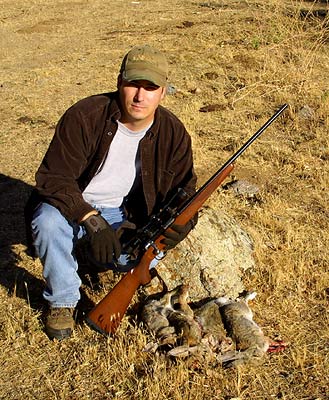 Well, I’ve received a lot of emails from people asking me what I do with the Cottontail Rabbits we shoot. Normally, if we are doing depredation shooting we will give the Rabbits away to the local residents in the area. Depending on the condition of the Rabbits and the caliber they were shot with, Cottontail can be great eating.
Well, I’ve received a lot of emails from people asking me what I do with the Cottontail Rabbits we shoot. Normally, if we are doing depredation shooting we will give the Rabbits away to the local residents in the area. Depending on the condition of the Rabbits and the caliber they were shot with, Cottontail can be great eating.
This is a picture expose’ of how to clean a Rabbit. There are probably 50 different ways to clean a Rabbit once the skin is off, but this is the way we’ve been doing it for years. It’s fast and does not waste much meat. Unless you can consistently make head shots, this is the way we do it when chest shots are the norm. If anyone has any questions, feel free to post on the Varminter Forums .
 You’ve made the shot and you have a nice brace of Cottontail Rabbits. What now?
You’ve made the shot and you have a nice brace of Cottontail Rabbits. What now?
Begin by skinning the Rabbit, starting from the back feet, carefully pull the skin off the Rabbit towards the head. It’s like peeling a sock off your foot. Remove tail and any other fur that was left over after the “peel”.
Once the fur is peeled up to the shoulder or head area, make a slit along the stomach to the base of the sternum. Be very careful not to puncture the intestinal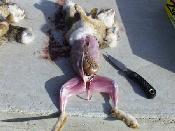 tract, if you do try your best not to get any of the bile on the meat. After making the first slit, carefully cut between the legs, cracking the bone until you get to the extreme lower intestine (basically where the round poop comes out).
tract, if you do try your best not to get any of the bile on the meat. After making the first slit, carefully cut between the legs, cracking the bone until you get to the extreme lower intestine (basically where the round poop comes out).
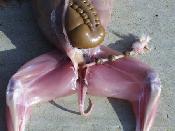 Again, carefully cut around this portion to separate it from the flesh between the legs. Holding the end hole closed with your thumb and forefinger, pull the tract out and place up along the side out of the way. It will still be attached to the intestines, but can be pulled out far enough to be completely out of the way.
Again, carefully cut around this portion to separate it from the flesh between the legs. Holding the end hole closed with your thumb and forefinger, pull the tract out and place up along the side out of the way. It will still be attached to the intestines, but can be pulled out far enough to be completely out of the way.
Once it is pulled out of the way, you will notice a sack filled with yellow liquid. This is urine, you do not want it to 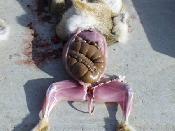 spill onto the meat. See close up pic #4 .
spill onto the meat. See close up pic #4 .
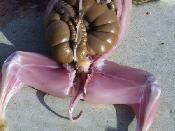 Note the lower intestine tract laying over the intestines and the yellow sack of urine.
Note the lower intestine tract laying over the intestines and the yellow sack of urine.
The yellow sack of urine can be removed by carefully pulling the intestinal tract 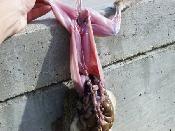 towards the front of the rabbit. I normally hang the rabbit upside down so gravity helps move the intestines and the urine sack down. If needed, use your knife to carefully loosen the urine sack and/or the intestinal tract. Pull the innards down as far as you can go, preferably to the middle of the ribcage area.
towards the front of the rabbit. I normally hang the rabbit upside down so gravity helps move the intestines and the urine sack down. If needed, use your knife to carefully loosen the urine sack and/or the intestinal tract. Pull the innards down as far as you can go, preferably to the middle of the ribcage area.
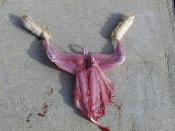 Once done with remove the intestines and other internal organs, check the meat for any spots or abnormal looking areas. If the Rabbit has been shot after the first frost of the year, you should have no problem with a nice healthy specimen. The feet can be cut off with a pair of sharp clippers. Cool your Rabbit immediately and soak in milk when you get home (my way of doing it).
Once done with remove the intestines and other internal organs, check the meat for any spots or abnormal looking areas. If the Rabbit has been shot after the first frost of the year, you should have no problem with a nice healthy specimen. The feet can be cut off with a pair of sharp clippers. Cool your Rabbit immediately and soak in milk when you get home (my way of doing it).
Editor’s Note: “Tularemia is a bacterial disease of rabbits that is transmittable to man, usually through openings in the skin. Hunters who notice small white or yellow spots on the surface of the rabbit’s liver when they are field dressing it should discard the entire rabbit immediately. During the early stages of the disease the liver can appear normal, though the infected rabbit may behave oddly, move slowly or be easily captured. It is a good idea to wear rubber gloves when dressing a rabbit and it is important to always cook rabbit meat thoroughly. Tularemia is transmitted between rabbits by fleas and ticks. The rabbits usually die from the disease, but it is not normally a problem once there has been a good hard frost and the temperature remains cool. A hard frost kills ticks and fleas which carry the disease and any rabbit infected prior to the freeze will normally die within a few days of contracting the disease.”
By: Eric Mayer
- Podcast with Soul Seekers Nation From the 2025 SHOT Show - February 17, 2025
- Complete Overview of the .17-5.56 KAK Cartridge by KAK Industry - July 21, 2024
- AGM Global Announces New and Upgraded Optics at the 2024 SHOT Show - February 1, 2024


